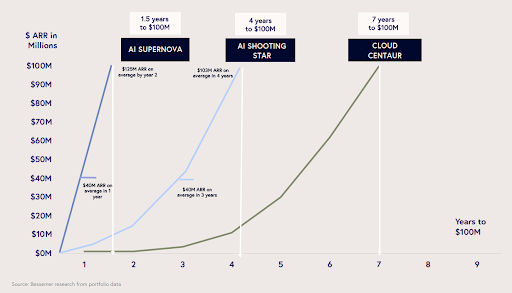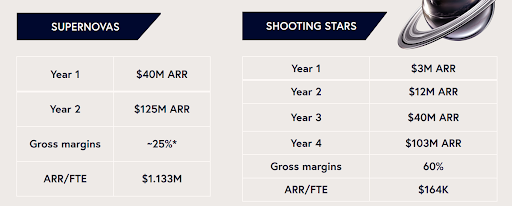
Vector over velocity: a founder playbook for durable AI growth
Founders are watching two very different AI stories unfold. Some teams rocket to big revenue almost overnight; others compound steadily with better margins and retention. Both paths exist – but what separates durable growth from flash-in-the-pan isn’t raw speed. It’s vector: speed in the right direction.
A useful framing comes from a recent venture analysis: when you chart the run to $100 million ARR for today’s AI startups, two trajectories show up. One is a steep-burn curve that sprints to massive revenue in the first 18–24 months; the other is a compounding curve that builds more gradually over ~four years with stronger efficiency.

Crucially, the inputs powering those curves differ. Snapshots of company-level benchmarks show the fast sprint often coincides with thinner gross margins (sometimes near or below zero), while the compounding path trends closer to traditional software efficiency.

The goal isn’t to pick a “team.” It’s to set up your product and operating model so you can move fast without eroding staying power. Here’s a practical playbook you can apply this quarter.
1) Start with one sharp wedge – then earn expansion
Choose a single, high-friction job where you can deliver a clear 10x improvement (time saved, accuracy, dollars recovered). Narrow scope accelerates learning loops, makes evals meaningful, and keeps compute costs sane. Your first win should be undeniable and explainable in plain language. (Save the second and third use cases for later.)
2) Make memory your moat
Great AI products remember – safely and with user control. Persistent context (preferences, prior tasks, domain artifacts) turns a generic model into my assistant. Build an earned-autonomy ladder: request permissions gradually, show receipts, and make “undo/forget” obvious.
3) Treat private evals and data lineage as first-class
Public leaderboards won’t tell you if your agent handles your customers’ spreadsheets, accents, or compliance risk. Stand up reproducible evaluation on your own data with clear pass/fail gates and human-in-the-loop for edge cases. As base-model performance converges, the real advantage is knowing when, where, and why your system works.
4) Build where users already live – the browser is becoming the operating layer
Agentic AI is shifting from chat boxes to doers that observe, reason, and execute across tabs and apps. The browser is emerging as the most natural surface: ambient, contextual, and already in the loop of daily work. Design for this substrate now: DOM-aware agents, explicit confirmations, and a user-visible audit trail.
5) Concentrate your cohort; don’t diversify your struggle
Most accelerators diversify cohorts across categories; the result can be a dozen teams solving unrelated problems. Consider the opposite: concentration. When five to 10 teams tackle the same workflow family, supplier terms, data-collection playbooks, redaction templates, and safety checklists standardise by week three. Even outside formal programmes, founders can form “micro-guilds” and meet weekly on hard metrics.
6) Price for outcomes, not just access
AI reshapes pricing expectations. Buyers increasingly look for usage- or outcome-aligned models (per conversation, per resolution) rather than pure seats. Consider hybrid plans - seat + usage with guardrails and visible value meters and keep close watch on tokens/compute per active user so growth doesn’t quietly tax your margins.
A lightweight shipping checklist
- Time-to-value under 60 seconds: if a new user can’t get a “wow” in a minute, you’ll pay for activation every time
- Reversible by default: drafts before send, one-tap undo, and human handoff for sensitive actions
- Memory with consent: clear settings, visible receipts, and a “forget this” affordance
- Private evals every release: track a stable golden set and a rotating “live set”
- Outcome-aligned pricing: make value meters visible (minutes saved, cases resolved)
- Cost guardrails: watch compute per active user like a hawk
- Browser-native ergonomics: confirmations, logs, and a simple way to inspect what the agent did
The paradox of this moment is that you can move faster and build deeper moats – if you choose vector over raw velocity. Start narrow, remember well, evaluate privately, meet users in the browser, concentrate your cohort, and align price to outcomes. That’s how you compound.
For more startup news, check out the other articles on the website, and subscribe to the magazine for free. Listen to The Cereal Entrepreneur podcast for more interviews with entrepreneurs and big-hitters in the startup ecosystem.

